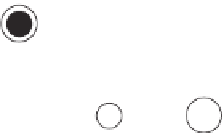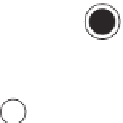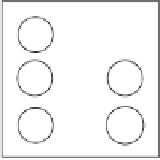Information Technology Reference
In-Depth Information
Polarization = 1
Binary value = 1
Polarization = 0
Binary value = Null
Polarization =
1
Binary value = 0
−
Figure
4.3.
In the six-dot cell, the two center dots enable a third electronic
configuration. In this third configuration, the cell is said to be in the NULL state,
in which the cell does not drive adjacent cells to any particular polarization.
third low-lying electronic configuration with no net cell polarization [28, 32], as
shown in Figure 4.3. To force the cell into this NULL state, the potential energy of
these two sites can be controlled using coupled electrodes, and this ability provides
a convenient and potentially more robust mechanism for clocking QCA circuits
[22, 28, 32, 47].
Adjacent cells interact via electrostatic coupling—a quadrupole moment
established from the nonuniform distribution of cell charge in each ACTIVE
cell lowers the energy of one of the two ACTIVE states in neighboring cells,
forcing those cells to relax preferentially to one state. The resulting cell-to-cell
interaction function is highly nonlinear as shown in Figure 4.4, and the
Cell
−
cell response function
1
0.8
0.6
0.4
0.2
0
−
1
−
0.8
−
0.6
−
0.4
−
0.2
0
0.2
0.4
0.6
0.8
1
−
0.2
−
0.4
−
0.6
−
0.8
−
1
Driver cell polarization
Figure
4.4.
Nonlinear cell-cell response function. The output cell is almost
completely polarized for a small polarization of the input cell (bold outline).
























Search WWH ::

Custom Search